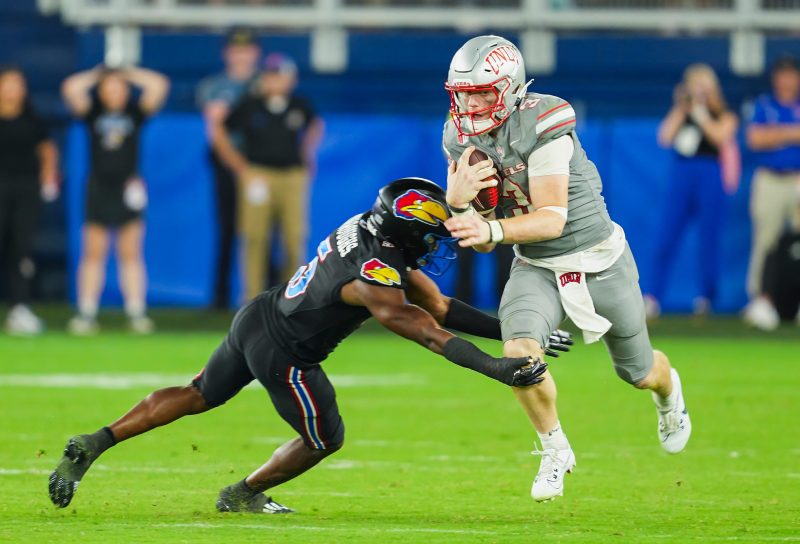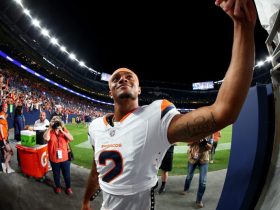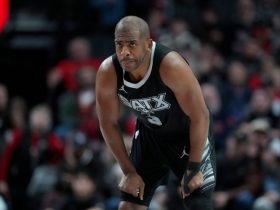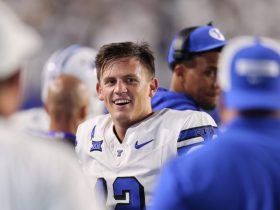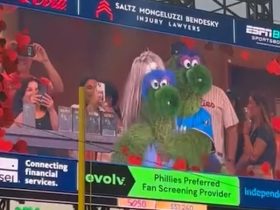The first version of the story – his version – is that a UNLV assistant coach verbally promised him a $100,000 name, image and likeness payment after transferring from Holy Cross and that the money never materialized when he got on campus.
The second version – the narrative being spun by people friendlier to UNLV – is that Sluka demanded a raise, so to speak, after becoming the starting quarterback for a 3-0 team that is well-positioned to make a run at the College Football Playoff.
In NIL’s “Wild West” era, both scenarios are plausible because they have happened dozens of times before at schools across college sports. The difference now is that we heard about it through a statement in which Sluka said he’s walking away from the team and preserving the rest of this year’s eligibility as a redshirt.
This unusual situation is like rocket fuel for debates around NIL the last three years. The lack of oversight around NIL in general, the bad-faith grifters and incompetent agents trying to make an easy buck, the fundamental economic rights of college athletes and the delicate locker-room dynamics around money are all featured characters here. Depending on how you view college athletes being paid, and given the lack of clear evidence about how this went awry, you can choose your own narrative on this one.
But it should be a wake-up call for everyone who has twisted themselves into a pretzel trying to avoid an employment model for college athletes. Until schools take responsibility for being an employer – just like every other multi-billion dollar sports league – the challenges around building and maintaining rosters are going to continue resulting in chaos and consequences that make the entire operation look unserious at best and a breeding ground for malevolent actors at worst.
Some will argue that all of these hiccups are just part of the growing pains as college sports transitions out of an era where it was taboo to pick up the tab for a college athlete’s pizza to one where assistant coaches wear T-shirts during practice bragging about paying players. Just good old American capitalism at work, baby.
But there’s really no industry in this country right now where capitalism operates as unfettered as college sports and NIL, with nary an enforceable regulation to be found. And the result?
It’s been mostly great for the players, who have the opportunity if they so choose to shop themselves on the open market every year for a better deal and a new team. It has been miserable for coaches and administrators, whose rosters have to start almost from scratch every year and are operating in a silo of misinformation with every decision about what a player’s actual value is on the open market. And it has proven to be an endless treadmill for collectives, these semi-independent booster entities who can never stop raising money, lest the kitty runs out to cover the next batch of recruits and transfers.
Did UNLV’s collective not have enough money to make this go away? Did the school want to draw a red line about the consequences of trying to ask for $100,000 in the middle of the season? We may never really know.
UNLV’s official statement is that Sluka made “financial demands … in order to continue playing,” which the school interpreted as a violation of NCAA rules.
“UNLV does not engage in such activity, nor does it respond to implied threats,” the statement said.
UNLV’s collective put out a statement denying it had ever made a $100,000 offer and insisting that it has upheld all of its contract and financial commitments this season.
No matter whom you believe, though, the fallout is going to be real for UNLV, whose football team and remaining players were left in the lurch by a teammate, and for head coach Barry Odom, who will have to do some reputational cleanup on behalf of his staff.
Though there’s no reasonable way to determine how often this kind of thing has happened behind the scenes, the coaching community in football and men’s basketball particularly has an endless supply of anecdotes from the last three years – ranging from misunderstandings about what was offered, collectives hanging on by their fingernails to make payroll and agents threatening to pull players out of otherwise good situations due to financial disputes.
Sure, college sports is booming. Seats are full, television ratings are up, interest continues to explode despite how chaotic the sport seems.
But no business with stakes and dollar figures this significant should be run so haphazardly and with so little oversight of financial transactions that essentially function as a salary.
There’s one major hurdle, though, to getting control of the NIL environment: Any attempt by schools or the NCAA to restrict how the collectives operate is going to get legal pushback and be subjected to scrutiny over antitrust violations.
Even the House v. NCAA settlement, which carves the pathway for schools to directly share revenue with players for the first time, has been held up by concerns from Northern District of California Judge Claudia Wilken over some limits on NIL/collective activity.
The only answer that solves it is to make college athletes employees and have the rules of the road standardized and agreed to through a collective bargaining process – just like in every professional sport.
University presidents and NCAA officials have spent tens of millions in legal fees and lobbying in Washington, D.C., over the last few years to avoid that outcome. They will seemingly make any concession possible to avoid athletes becoming employees.
But as long as NIL collectives exist in their current form, with practically no rules, standards, oversight or transparency on the deals they make with players, the UNLV-Sluka dispute is undoubtedly going to be the first of many that blows up publicly in the middle of a season.
If schools are comfortable with that trend, by all means they should continue on the current path. If they want some control back and to bring order to athlete compensation, making them employees is really the only solution.

